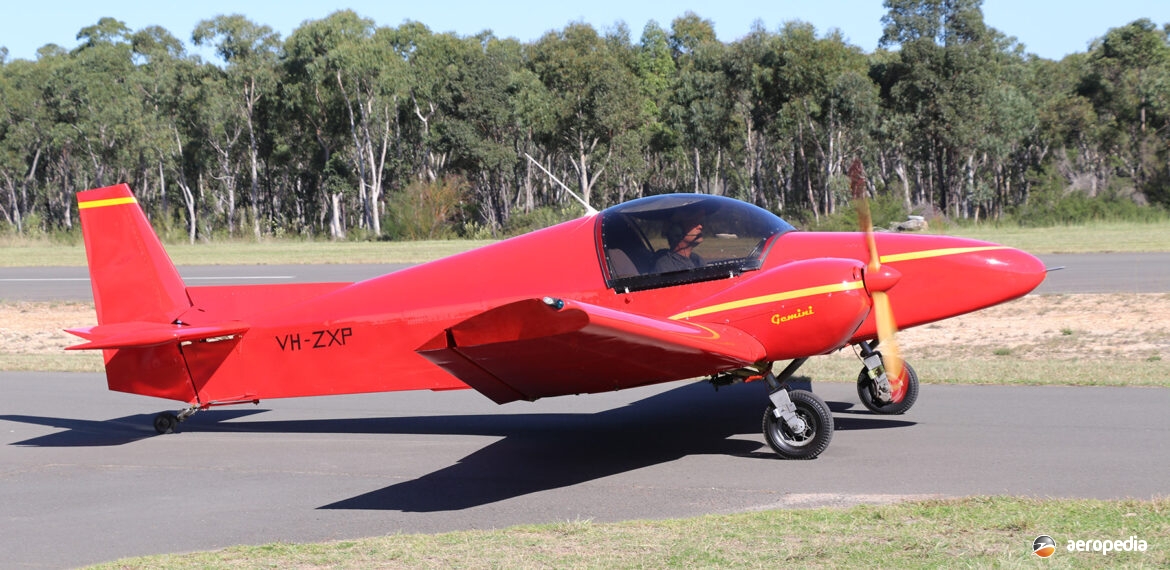Photograph:
The prototype Gemini as VH-ZXP (c/n 001) at Wedderburn, NSW in 2019 (David C Eyre)
Country of origin:
Canada
Description:
Two-seat twin-engine light sport aircraft
Power Plant:
Two 60 kw (80 hp) Jabiru 2200 four-cylinder horizontally-opposed air-cooled engines
Specifications:
- Wingspan: 8.31 m (27 ft 3 in)
- Length: 5.79 m (10 ft 0 in)
- Height: 1.78 m (5 ft 10 in)
- Wing area: 11.43 m² (123 sq ft)
- Max speed: 249 km/h (155 mph)
- Max cruising speed at 75% power: 233 km/h (145 mph)
- Stallng speed with flaps down: 89 km/h (55 mph)
- Service ceiling: 4,877 m (16,000 ft)
- Rate of climb: 390 m/min (1,280 ft/min)
- Fuel capacity: 129 litres (28 imp gals)
- Range with no reserve: 1,046 km (650 miles)
- Take-off distance: 137 m (450 ft)
- Landing distance: 137 m (450 ft)
- Empty weight: 363 kg (800 lb)
- Loaded weight: 658 kg (1,450 lb)
History:
The Gemini was designed in Canada by Christopher Heintz of Zenair Ltd as a light sporting aircraft with twin-engine performance and reliability, to be made available to interested parties in kit form, which was affordable and easy to build. It was described as having a true cross-country ability with a capability of carrying equipment for overnight trips, and having additional panel space to allow for a custom avionics installation. The airframe was based on the CH-601 series.
The prototype, flown for the first time on 23 July 1996, featured a centre-mounted control stick accessible from both the left and right-hand seats. The engine controls quadrant was on the left side of the cabin and it had dual rudder pedals to provide steering for the nosewheel in the aircraft built with a tricycle undercarriage, or for the tailwheel in aircraft built with that configuration. Hydraulic brakes were to be installed with differential braking.
Construction was modular, with one section assembled at a time to minimise space requirements, the wings and tail section to be built first. The fuselage was to be built in two sections to minimise the space needed to build the aircraft. The wing section had an 18% constant chord aerofoil with tapered outboard wing sections. The outboard panels could be removed quickly from the centre section and were to be fitted with full-length mass-balanced ailerons at the trailing-edge. The conventional horizontal tail had a fixed stabiliser and a large elevator fitted with an electric trim tab. The fully-flying vertical tail was all-moving. It was able to be fitted with a retractable undercarriage or a fixed undercarriage.
The wing spar was made up of three sections, a fuselage centre section and two outboard wing panels. Aluminium wing tanks were installed behind the wing spar in the outer wing panels. Power was by two Jabiru 2200 four-cylinder engines driving two-blade fixed-pitch 1.40 m (4 ft 7 in) propellers. It seems consideration was also given to installing Jabiru 3300 six-cylinder engines in production aircraft. The design was developed to meet the “51% rule” making it eligible for the Experimental and Amateur-built categories in the United States.
The prototype N6265N was first shown to the public on 31 August 1996 at the Zenair Ltd facility at Midland, Ontario, annual Open House event. It was also during that year flown to Oshkosh, Wisconsin, USA where it was shown in a natural metal finish at the EAA event. Later that year it appeared at the Sun ’n Fun event in Florida. The aircraft was later painted overall red with a thin yellow stripe down the side. By 2016 it seems the aircraft design had not entered production and was still facing some development.
The aircraft design in later years received further development with the designer, Chris Heintz, looking at a different aerofoil for the wing which would be better suited to the twin-engine configuration, and other changes, before it was to be produced as a kit available for amateur builders . For some time the aircraft was based in Missouri and during testing completed approximately 110 hours. By late 2016 it seems the Company was busy developing and producing other designs so the Gemini was not proceeded with at that stage.
In December 2015 the prototype aircraft was purchased by a Sydney pilot, Armando Papallo, and, minus engines, it was shipped to the Sports Aircraft Association field at Wedderburn, NSW, where work proceeded on completing the aircraft, with the undercarriage initially fixed in the down position and two new engines and propellers fitted, a Cammit 2200 unit on the port wing and a Jabiru 2200 on the starboard wing. It has since been regularly flown from the Sydney airstrip.

